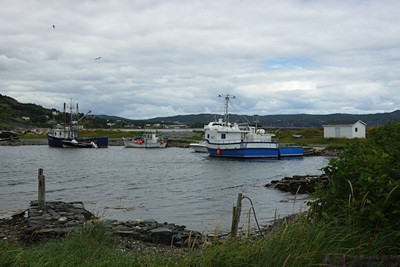SATURDAY 20 August
(NOTE: There are 17 photos in this post, all but one of which have to do with our visit to the NHS. They are distributed throughout the post with captions.)
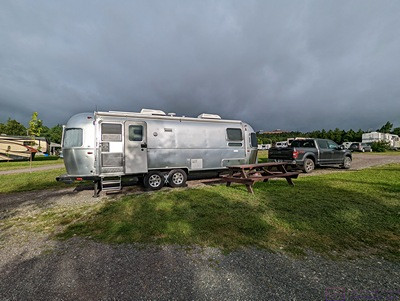
We had bright sun when I got up but dark clouds in the west. This combination always makes for dramatic lighting. And what better to photograph than a 2020 Airstream Flying Cloud and a Ford F-150.
I slept in this morning and finally got up around 7:45 AM. Linda got up just before me, so she made our morning coffee. I checked to see if my computer would connect to the park Wi-Fi. It wouldn’t, but I did not expect that anything had changed since last night. For breakfast, I had one of my (vegan) raspberry strudel sticks and Linda had a piece of the molasses raisin bread we bought at Sobeys the other day. We both took showers, after which I dumped the contents of the waste tanks.

This is a composite image of Ferryland Harbor. The Colony of Avalon archeological site is at the right side at the base of the hill, inside the small protected harbor.
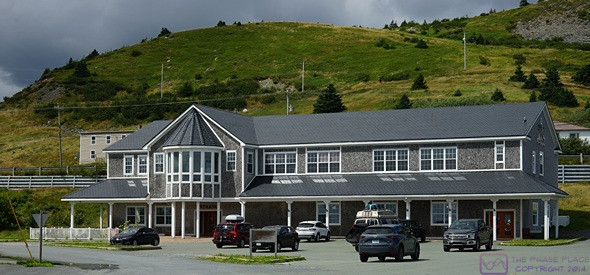
The main building for the NHS. It houses: admission, museum, archeology lab, and administration for the Foundation.
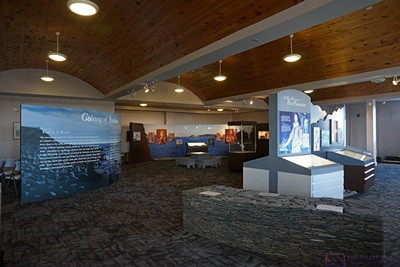
This photo gives an idea of the arrangement and appearance of the museum in the main building. It was very nicely done and the main public display of artifacts was here.
An iPadOS update (15.6.1) was available, so we installed it on both of our tablets. In looking at the network configuration of my iPad Pro, I noticed that it was using IPv6 on a 5 GHz Wi-Fi band. I presumed that Linda’s iPad was doing the same. I wondered if the problem we were having with our laptop computers might be related to IPv4, or perhaps to a 2.4 GHz Wi-Fi band. I had checked last night, and my laptop computer is configured to use both IPv4 and IPv6, so it seemed unlikely that this was the problem. I checked my phone this morning, and it was connected to the Pippy Park Wi-Fi on a 2.4 GHz, band, so the loss of 2.4 GHz service did not appear to be the problem either. It’s “a riddle wrapped in a mystery inside an enigma.” (Winston Churchill).
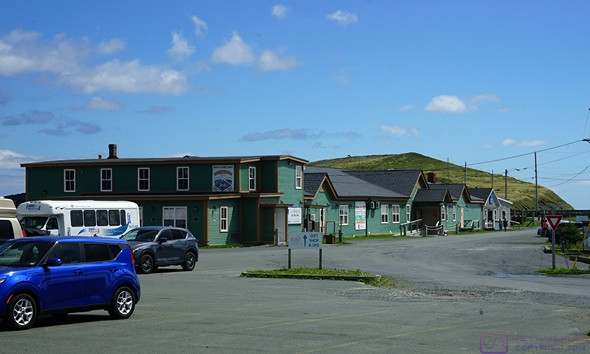
This is the other non-historic building that is part of the NHS. It houses: Tetley’s Tea Room (restaurant and tea bar), dinner theater, gift shop, and 17th-Century Kitchen.
In thinking about our last two full days in the St. John’s, Newfoundland area, we knew we wanted to visit the Lord Baltimore’s 1623 Avalon Colony National Historic Site. It’s south of Witless Bay, and we will be in that area tomorrow for a boat trip to see the Witless Bay Ecological Reserve, so our initial thought was to do both things tomorrow. But we also wanted to return to Peaceful Loft this evening for an early dinner (before 5 PM) and possibly do laundry later in the day tomorrow. The weather forecast for today and tomorrow was good, and we decided to just do the extra driving and visit the Avalon Colony NHS today. Google maps said it would take about an hour and 15 minutes to get there.
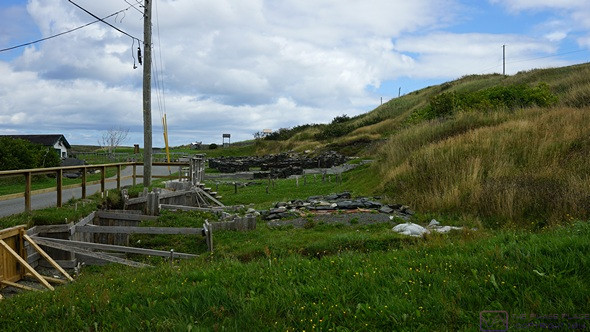
This is the beginning of the site of the archeological dig at the end of the harbor and the base of a large hill.
There was wind in the forecast for today, because there is always wind in the forecast here. We closed up the trailer and turned on one of the heat pumps in cooling mode, just to make sure it didn’t get too warm. We made sure Juniper-the-cat had her afternoon meal in her food bowl and plenty of water in her water bowl, and were out the door by 10:30 AM.
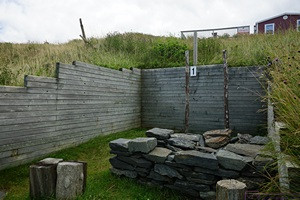
The flat stones are the original forge. The tow wooden posts in front would have been the location of the anvil, quench pot, and other smithing apparatus. The two tall poles in the back mark the likely location of the bellows support. The retaining walls correspond to the location of the original building.
Most of the drive was on Hwy-10, which was eventually also signed as “The Irish Loop.” And no sooner did we see the first such sign, we began seeing businesses, and signs for businesses, as well as road names of Irish derivation. Hwy-10 was a basic 2-lane road. The speed limit was sometimes 80 km/hr, but frequently dropped to 50 km/hr, and often for quite a few kilometers. It repeatedly climbed to high ground and dropped back down close to sea level at towns nestled at the ends of bays, and was rarely straight. In other words, a fun road to drive. What we did not see on the drive, or when we arrived at the Avalon Colony National Historic Site, were the Parks Canada signs with “Parky the Beaver.”
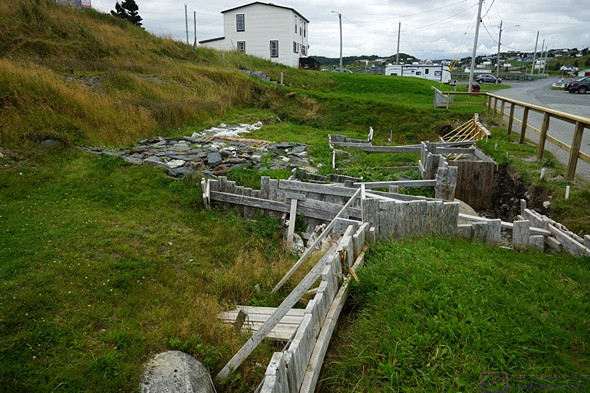
This photo shows the excavation occurring on at least three different levels (depths). It was amazing how deeply buried the site was after “only” 400 years. Our tour guide explained that sites such as this colony often abandoned after being attacked or suffering damage from weather. But people often returned and rebuilt on top of what was already there. The layering that occurs from this multiple use over time is both challenging and interesting for the archeologists. Note the white house in the background with the travel trailer to its right. The owner of this house is the person who found some “interesting bits and pieces” while digging for worms on his property. He took them to the archeology department at Memorial University where they were immediately recognized as significant finds. Permission was granted to dig three test holes. The first one was where the travel trailer is now parked. The archeologists new immediately that this was an old site of great importance, probably the lost Avalon Colony.
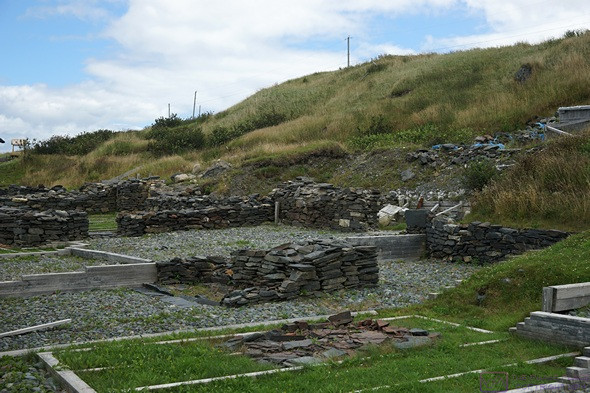
This photo shows what remains of the walls of one of the buildings. The buildings here were made from stacked stone and had slate roofs. They had fireplaces that served for heating and cooking, and their locations are clearly visible.
The site included a museum and offered a guided tour of the archeological site for 13$ / person (senior rate), which we gladly paid as our Parks Canada Family Discovery Pass did not apply here. (I looked this up later in the day and found the following from the Wikipedia entry National Historic Sites of Canada – “As of July 2021, there were 999 National Historic Sites, 172 of which are administered by Parks Canada; the remainder are administered or owned by other levels of government or private entities.”) The museum required the paid admission, but we could have visited the “dig “ for free.
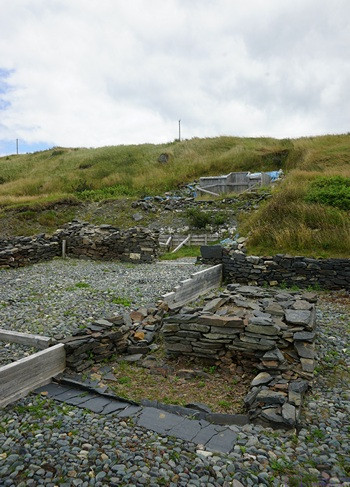
This photo shows the excavation working its way up the hill. Evidence indicates that the main part of the colony was surrounded by a palisade (wooden post wall) about seven feet high. It was not clear to us if the archeological work here has yet determined the complete scope of the colony, especially outside the palisade.
The Lord Baltimore 1623 Avalon Colony NHs is owned and operated by the Avalon Colony Foundation, although the National Trust for Canada seems to also be involved. The site itself is located on a natural harbor and there were two modern buildings, lots of parking, and the archeological dig site. One building contained the reception area, museum, archeology lab, and administration functions. The other building contained Tetley’s Tea House (a restaurant and tea bar), a dinner theater, a gift shop, and a “17th Century Kitchen.” The archeological site was a short walk down to the end of the harbor from the second building, so everything was in close proximity.
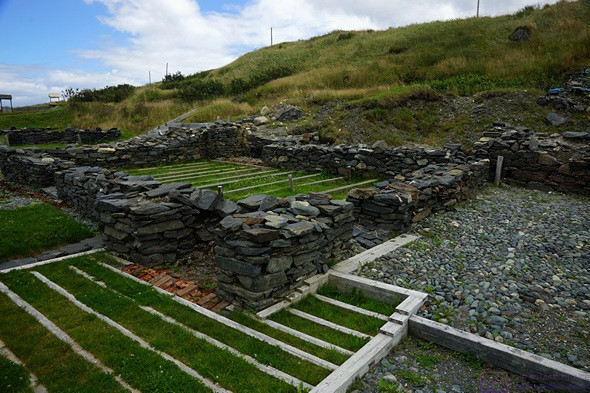
The archeologists are fairly sure that this was the house of Lord Baltimore. It’s larger than the others, and was a full 2-story building.
We had an hour to wait for the next tour, so we watched a short film about the discovery of the site and the archeological work that has taken place to date. When took our time in the museum reading about the history of the place and looking at the artifacts on display. We learned that I n 1623, Sir George Calvert (Later Lord Baltimore) obtained a charter for this part of southeast “New-found-land” and named the peninsula after the Arthurian Isle of Avalon. However, cod fishing had been taking place along this coast since at least the early 1500’s by Basque, Portuguese, and French fisherman, and eventually English fisherman as well. The practice at the time, however, was to “wet salt” the fish and keep them in the hold of the ship until returning home. Calvert sought to establish a permanent settlement and land-based drying racks came into use there.
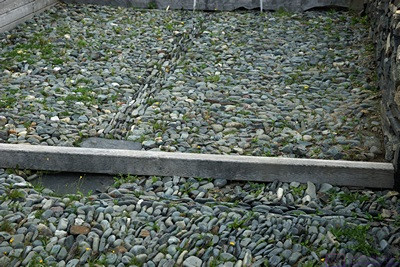
Careful inspection of this photo will show rocks in the upper middle portion arranged running from a little upper right to a little lower left. This was done for drainage. There are also drainage stones just in front of the horizontal timber, running from the right edge of the frame to the left.
Some of the history of what happened here, and when, was known but the exact location of the colony had been lost to time. The story that fascinated us was the discovery of the site in the 1990s, and the archeology that has taken place here since then, and is still on-going today. The initial archeological work was under the direction of an archeologist from Memorial University (which happens to be located adjacent to Pippy Park). We got the impression that archeologists and archeology students from there are still very much involved in the on-going work. There are even programs for visitors to participate for an hour or a day.
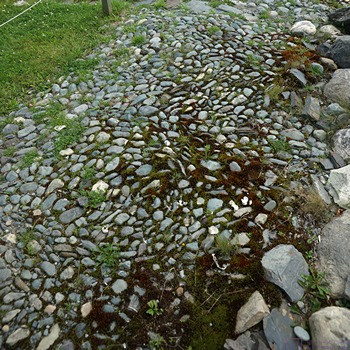
Avalon Colony had a cobblestone street, parts of which have been excavated. Based on what has been done so far, they know that most of the street lies under the modern paved street that is now part of the working harbor.
We were glad we went on the walking tour of the “dig”. There were only four of us, and the young man doing the tour did a nice job of explaining what we were seeing at each stop. Had we been here on a weekday, we might have seen archeologists working the site, and been able to see the lab. Timing really is everything.
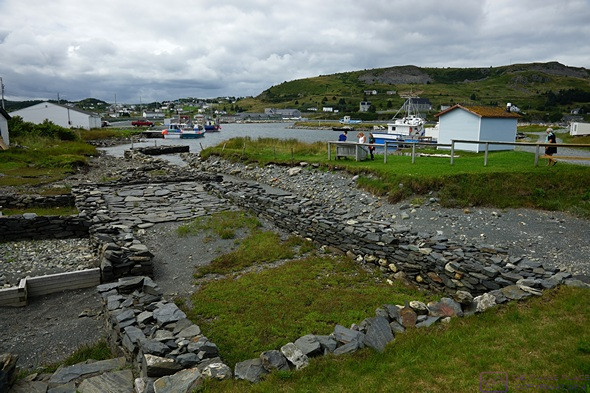
This building was at sea level and was the working dock and storeroom. Waste flowed down to here and was (in principle) washed away with the tide.
As the physical structure of the site has been revealed, and artifacts unearthed and identified, they have led to a deep insight into early colonial English life in North America. The following sites provide more information:
From Parks Canada (www.pc.gc.ca) “Colony of Avalon National Historic Site of Canada is a 17th-century archaeological site 60 kilometres south of St. John’s, Newfoundland.”
From the Colony of Avalon Foundation (colonyofavalon.ca) “Colony of Avalon in Ferryland Newfoundland is a premiere historical destination and archeology dig.”
From the National Trust for Canada (nationaltrustcanada.ca) “The Colony of Avalon is recognized as the best preserved early English colonial site in North America. Today, on-going work at the Colony is changing the way we understand the past.”
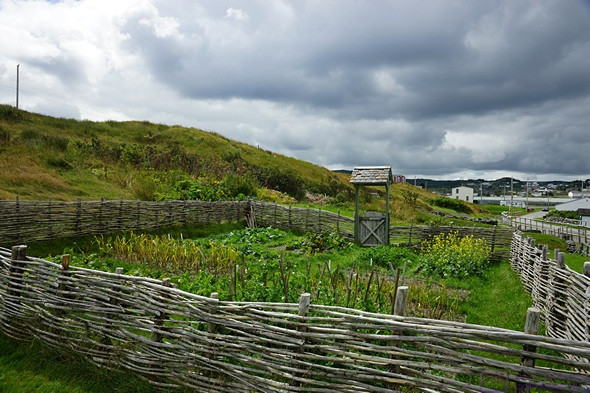
The gardener had a house outside the palisade, perhaps because they arrived later and there was no more room inside the enclosure. Shown here is a recreation of what the garden probably looked like. Of note is the “woven” fence.
We spent a few minutes in the gift shop and Linda bought a Puffin Christmas tree ornament. The 17th-Century Kitchen is normally part of the tour, but they were short-staffed, and the “cook” was minding the gift shop.
When we concluded our visit, we decided to head directly to the Peaceful Loft restaurant in St. John’s for an early dinner. What we found when we got there was that downtown St. John’s on a lovely Saturday afternoon was a madhouse of people. What we did not find was a place to park. Linda’s foot was sore from our long hike yesterday and we decided to bale out on our dinner plans and return to camp. We considered going to Blaze Pizza for an early dinner, but decided to dine in. While Linda prepared our dinner, I powered up my laptop and was thrilled that my computer connected to the park Wi-Fi! We were not here all day, so I have no idea what, if anything, someone might have done with the system. I only had time before dinner to check my e-mail and back up some files. I set the computer aside, but did not shut it down.
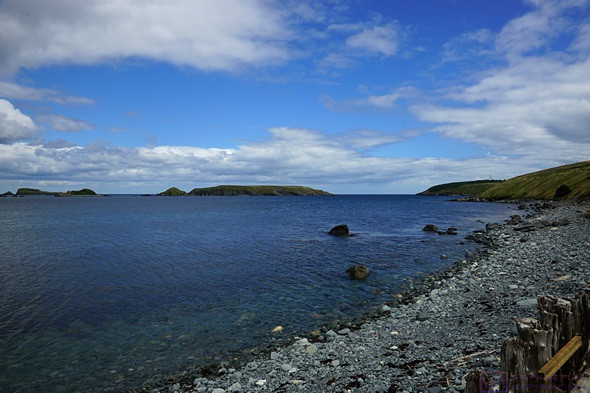
This is a view from the north end of the colony site looking out through Ferryland Harbor to the North Atlantic Ocean. The first gap from the right was the only navigable passage out to the ocean. Everything to the left is a chain of islands that are connect to the mainland with shallow water depths in-between.
Dinner was a simple affair of fish fillets with tartar sauce, Daiya Deluxe Cheddar Style Cheezy Mac, orange juice, and fresh strawberries. All vegan, of course. We had some Skinny Pop microwave popcorn later in the evening for a snack.
When I went to use my computer again, it had disconnected from the park Wi-Fi and would not reconnect. I ran the Windows networking trouble-shooter and tried shutting down and restarting my computer, but nothing worked. I concluded that the park has a serious problem with their Wi-Fi Router, which is not going to get fixed before we leave on Monday morning, and I did not need to spend any more time dealing with it. I connected my Pixel 6 Pro to the park Wi-Fi (which worked great) and then turned on the hotspot feature and connected my computer to that (which also worked great). I had access to unlimited high-speed Internet on my computer, and was able to efficiently upload and assemble the blog post for yesterday. In spite of this technology glitch, we both still really like this campground.
…
